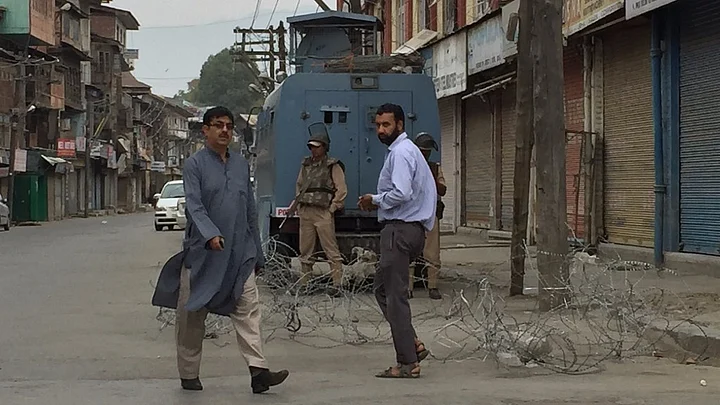This is my first visit to Kashmir ever since the unrest flared up in the Valley following Burhan Wani's killing. What I experienced has left a deep impact on me. The last time I came here was to cover the floods of 2014. Back then, despite facing acute difficulties and financial losses, the people had been friendly and hospitable.
But today, as I walked the streets in a jeans and a top, I felt several suspicious eyes watching me closely. My clothes made me stand out as a non-Kashmiri, maybe even a journalist. Of course, they must have thought, she was here to report on the situation in the Valley.
While traveling across Srinagar in a taxi to get a sense of the situation, I decided to get down at a spot in Lal Chowk. Several fruit and vegetable vendors had set up shop here. I told the cab driver to park the car close to the vendors. I got down from the vehicle with my mobile phone and nothing else. It was around 2 pm. Walking up to one of the fruit sellers, I bought some of the famed Kashmiri apples. I tried to talk to the vendor but failed to draw a response.
A little further, I came across a man peddling ‘Kashmiri singada’ (a type of fruit). Finally managing to strike up a conversation, I posed some questions to him.
Do you set up your stall here every day?
No madam, although I want to. This is my only source of income but I am unable to do so.
Why not?
Two days ago, when I was hawking my fruits, a few protesters came and threw all my singadas on the road. They even damaged my cart. They threatened to do so again if I put up my stall.
Where did this happen?
Just 2 km from here. I have no option but to sell fruits, I have to feed my family.
Our entire conversation happened in less than a span of 2 minutes. By then, he had packed up all his wares. Suddenly, a young Kashmiri boy showed up and stood next to him. The vendor became quiet. To change the subject, he said to me after a bit, 'Madam, yahin kha kar dekhiye, bahut tasty hai, aap phir bolenge half kg aur pack kar do (Have the fruit right here, and you will want to buy more.)’
The hint was enough for me to leave and I went back close to my cab. I wanted a few pictures of the place for my story. This was the only area where I had come across several vendors sitting together. In the rest of the city, apart from chemist shops, all other establishments were closed. Only fruit and vegetable sellers could be seen in scattered spots.
I pulled out my mobile phone and tried get a long-view photograph of the vendors. While I was trying to adjust a frame, another young Kashmiri boy came up to me. He asked me not to take the photograph, his tone and manner bristling with anger.
I told him I was only taking a picture, but he wouldn’t let me. When I asked him why not, he shot back that I should go away from here. By now, everyone around was staring at me, but no one came forward to help.
I thought it best to move away. Walking 5-10 steps away from the spot, I again tried to get a shot. Once again, the boy strode up to me. "You can't take a photograph of these vendors," he fumed. When asked for a reason again, his face turned a deep red with rage. "I said ‘no'”, he growled back. I was left with no choice but to leave. But the incident had left a deep impact on me.
As I got back into my waiting car, several questions jumped to my mind, which I asked the taxi driver. Why was the youth so offended when I was clicking a simple photo of a few fruit sellers? Had he guessed that I was a journalist? I could only draw some vague replies from the cabbie; but it didn’t matter, I already knew the answers to my questions.
To confirm them, I posed the same queries to a local senior journalist. I was told that for the past three months, the protesters have been claiming that curfew has been clamped in Kashmir. But the photographs of small traders going about their daily business would have junked their claims, and suggested that the simmering tension was waning and life was heading towards normalcy.
Later, I also learnt from top security personnel that Kashmiris are strictly adhering to the calendars released by the separatists every month, on social media or by other means. The ‘calendars’ dictate that from 6 am till 6 pm, all shops must stay shut and people should remain indoors. After 6 pm, a few grocery shops are allowed to open so that locals can stock up on a few food items.
Local are also issued instructions such as the time for holding marches, public meetings and protest in their villages and towns. The calendars are issued every Friday.
I had got a glimpse of life in the Valley after months of strife. My encounter with an angry Kashmiri youth had left a lasting impact on me. But at the same time, I know that there are still voices in the region that demand peace.
(At The Quint, we question everything. Play an active role in shaping our journalism by becoming a member today.)
